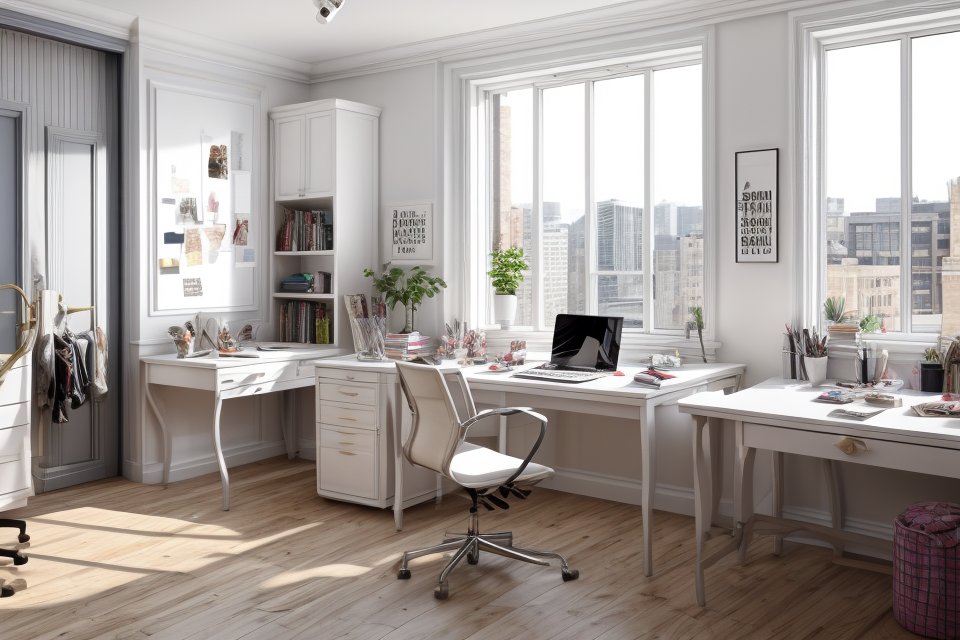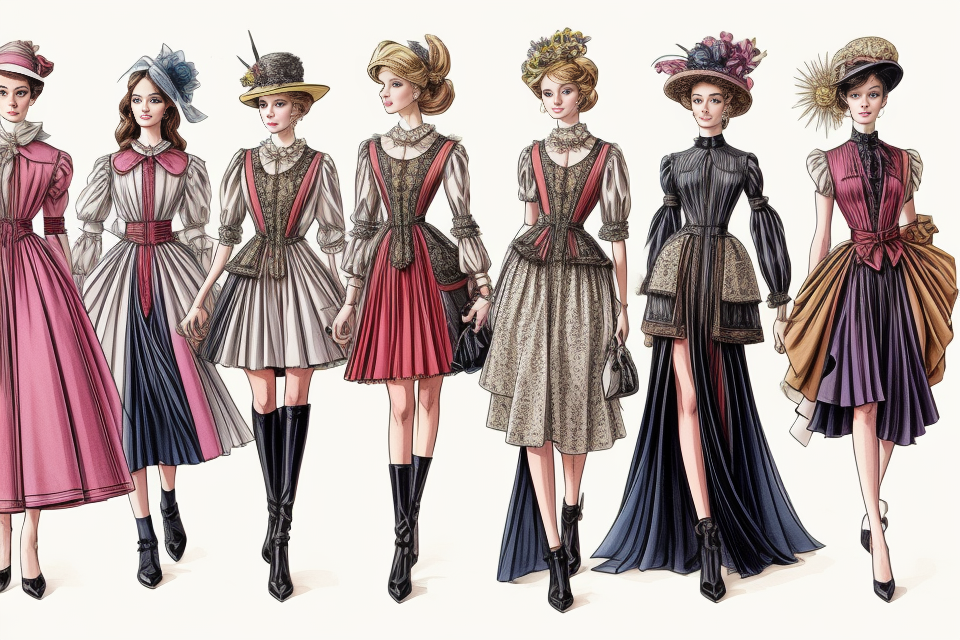
The world of fashion design is often perceived as a glamorous and exciting industry, filled with creativity and endless opportunities. However, behind the scenes, the journey of becoming a successful fashion designer is not as easy as it may seem. With long hours, hard work, and a fiercely competitive market, the question remains – is it really hard to become a fashion designer? In this article, we will explore the challenges and realities of pursuing a career in fashion design, and whether the hard work and dedication is truly worth it in the end. So, let’s dive into the world of fashion and discover what it takes to make it in this cutthroat industry.
Being a fashion designer can be challenging in many ways. It requires a lot of hard work, creativity, and dedication to succeed in this field. It involves a lot of work such as creating sketches, selecting fabrics, and working with production teams to bring designs to life. Additionally, the fashion industry is highly competitive, and designers must keep up with the latest trends and be able to adapt to changes quickly. It can also be difficult to balance the business side of fashion design with the creative aspect. However, for those who are passionate about fashion and have a strong drive to succeed, being a fashion designer can also be a rewarding and fulfilling career.
The Realities of the Fashion Industry
The Pressure to Create
The fashion industry is notorious for its fast-paced and competitive nature. One of the most significant challenges that fashion designers face is the pressure to constantly create new and innovative designs. This pressure comes from a variety of sources, including clients, consumers, and industry trends.
Meeting Clients’ Expectations
Fashion designers often work with clients who have specific visions for their clothing lines. These clients may have particular materials or colors in mind, or they may want designs that are more classic or contemporary. In order to meet these expectations, designers must be able to communicate effectively with their clients and create designs that meet their needs while still being original and innovative.
Innovating and Staying Relevant
In addition to meeting clients’ expectations, fashion designers must also stay ahead of the curve when it comes to industry trends. The fashion industry is constantly evolving, and designers must be able to adapt to new styles and technologies in order to remain relevant. This requires a deep understanding of consumer preferences and an ability to anticipate future trends.
Designers must also be able to innovate and create new designs that push the boundaries of what is possible. This requires a unique combination of creativity, technical skill, and business acumen. Fashion designers must be able to balance the artistic and commercial aspects of their work, constantly striving to create designs that are both aesthetically pleasing and commercially viable.
Overall, the pressure to create is one of the most significant challenges that fashion designers face. It requires a deep understanding of the industry, a willingness to take risks, and a constant drive to innovate and stay ahead of the curve.
Long Working Hours
Being a fashion designer often entails working long hours, which can take a toll on one’s personal life. Many designers find themselves working overtime to meet deadlines, often without the corresponding increase in pay.
Overworked and Underpaid
Designers may work for extended periods without breaks, putting in extra hours to finish a project or collection. This can lead to burnout and a lack of work-life balance, especially for those just starting out in the industry. Furthermore, many designers are paid relatively low salaries, despite the demanding nature of their work.
Balancing Work and Personal Life
The long hours and intense pressure to produce high-quality designs can make it challenging for fashion designers to maintain a healthy work-life balance. Many designers struggle to find time for personal pursuits or to spend time with loved ones, leading to stress and exhaustion. This can result in missed opportunities to recharge and refocus, which can negatively impact their creativity and productivity.
In conclusion, the long working hours required of fashion designers can be challenging and lead to burnout, stress, and a lack of work-life balance. While the demanding nature of the job may be a part of the appeal for some, it is essential for designers to find ways to manage their time effectively and prioritize self-care to avoid exhaustion and maintain their creativity.
Finding Success in a Competitive Field
Breaking into the Industry
Being a fashion designer requires not only creativity and talent but also perseverance and determination. Breaking into the fashion industry can be challenging, as there are many talented designers vying for the same opportunities. Aspiring fashion designers must be prepared to face rejection and criticism, and they must have a thick skin to survive in this competitive field.
To increase their chances of success, aspiring fashion designers should consider obtaining a formal education in fashion design, which can provide them with the necessary skills and knowledge to succeed in the industry. They should also gain practical experience by interning at fashion houses or participating in fashion competitions, which can help them build a portfolio and establish a network of contacts.
Establishing a Name for Oneself
Once an aspiring fashion designer has broken into the industry, they must work hard to establish a name for themselves. This requires not only creating stunning designs but also developing a unique brand identity that sets them apart from their competitors.
Designers must also be adept at marketing themselves and their designs, which can involve building a strong social media presence, attending fashion shows and events, and networking with industry professionals. Establishing a name for oneself in the fashion industry can take time and effort, but it is essential for success and long-term growth.
Despite the challenges of breaking into the fashion industry and establishing a name for oneself, many aspiring fashion designers find the rewards of a successful career in fashion to be well worth the effort. With hard work, determination, and a passion for fashion, anyone can achieve success in this exciting and competitive field.
The Skills and Qualities Needed to Succeed
Creativity and Vision
Being a fashion designer requires a unique combination of creativity and vision. Creativity is the ability to come up with original ideas and concepts, while vision is the ability to see and communicate a clear picture of what you want to achieve. Here are some key aspects of creativity and vision that are essential for a successful career in fashion design:
Staying Inspired and Motivated
One of the biggest challenges that fashion designers face is staying inspired and motivated. Fashion is a highly competitive industry, and it can be difficult to stand out and make a name for yourself. However, successful fashion designers know how to stay inspired and motivated by constantly seeking out new sources of inspiration and challenging themselves to come up with fresh ideas. This can involve researching current trends, looking to history for inspiration, or even just taking a break and letting your mind wander.
Developing a Unique Style
Another key aspect of creativity and vision in fashion design is developing a unique style. While it’s important to be knowledgeable about the latest trends and techniques, it’s equally important to develop your own unique voice and style. This can involve experimenting with different materials, silhouettes, and colors, as well as pushing the boundaries of traditional fashion norms. Successful fashion designers know how to stay true to their own vision and create designs that reflect their own personal style and aesthetic.
Business Acumen
Managing Finances
As a fashion designer, it is essential to have a solid understanding of financial management. This includes budgeting, forecasting, and financial reporting. A designer must be able to manage their finances effectively to ensure the success of their business. This involves keeping track of expenses, setting prices for products, and making strategic financial decisions.
Building a Network and Client Base
In addition to financial management, a fashion designer must also have strong networking and relationship-building skills. This includes establishing connections with suppliers, manufacturers, retailers, and other industry professionals. Building a strong network can help a designer gain access to resources, such as materials and manufacturing facilities, and can also help them secure clients and business opportunities.
Marketing and Branding
Another important aspect of business acumen for a fashion designer is marketing and branding. This includes developing a strong brand identity, creating a marketing strategy, and building a presence on social media and other platforms. A designer must be able to effectively communicate their brand and design aesthetic to potential clients and customers.
Negotiation and Communication
Finally, a fashion designer must have strong negotiation and communication skills. This includes negotiating with clients, suppliers, and manufacturers, as well as communicating effectively with team members and other industry professionals. A designer must be able to articulate their design vision and collaborate with others to bring their ideas to life.
Overall, business acumen is a critical skill for a fashion designer to possess. It involves a range of skills, including financial management, networking, marketing and branding, and negotiation and communication. By developing these skills, a designer can set themselves up for success in the competitive world of fashion.
Technical Knowledge and Skills
Being a fashion designer requires a unique set of technical skills and knowledge. Here are some of the most important aspects that aspiring fashion designers need to master:
Fashion Theory and History
A solid understanding of fashion theory and history is essential for any fashion designer. This includes knowledge of the different fashion movements, the evolution of fashion, and the cultural and social contexts that have influenced fashion over time. By studying fashion theory and history, designers can gain a deeper understanding of the industry and the role that fashion plays in society.
Materials and Techniques
In addition to fashion theory and history, designers must also have a deep understanding of materials and techniques. This includes knowledge of fabrics, textiles, and other materials used in fashion design, as well as the techniques used to manipulate and work with these materials. For example, designers must know how to cut, sew, and pattern fabrics to create their designs. They must also be familiar with different types of fasteners, such as zippers and buttons, and know how to apply them to their designs.
Drawing and Illustration
Fashion designers must also have strong drawing and illustration skills. This includes the ability to create sketches, mood boards, and technical drawings. These skills are essential for communicating design ideas to clients, manufacturers, and other industry professionals.
Computer-Aided Design (CAD)
Computer-aided design (CAD) is an essential skill for modern fashion designers. CAD software allows designers to create and manipulate digital patterns, prototypes, and designs. This can save time and reduce costs, as well as help designers to create more accurate and detailed designs.
Overall, being a fashion designer requires a broad range of technical skills and knowledge. By mastering these skills, designers can create stunning and innovative designs that push the boundaries of fashion and capture the attention of the world.
Challenges Faced by Fashion Designers
Overcoming Creative Blocks
Being a fashion designer requires a great deal of creativity, but sometimes the creative process can come to a halt. Here are some ways that fashion designers can overcome creative blocks:
Seeking Inspiration
One way to overcome creative blocks is to seek inspiration from external sources. This can include looking at other designers’ work, exploring different art forms, or even taking a break and going for a walk. By exposing yourself to new and diverse ideas, you may be able to spark your own creativity.
Collaborating with Others
Collaborating with other designers or artists can also help overcome creative blocks. By bouncing ideas off of one another and combining different perspectives, you may be able to come up with new and innovative designs.
Breaking the Rules
Sometimes, the best way to overcome a creative block is to break the rules. By challenging traditional design norms and expectations, you may be able to come up with unique and original designs that stand out from the crowd.
Experimenting with Different Mediums
Experimenting with different mediums can also help overcome creative blocks. For example, if you typically design clothing, try experimenting with accessories or footwear. By working with different materials and forms, you may be able to stimulate your creativity and come up with fresh ideas.
Taking a Break
Finally, sometimes the best way to overcome a creative block is to simply take a break. By stepping away from your work and coming back to it with fresh eyes, you may be able to approach your designs with renewed energy and inspiration.
Navigating the Business Side of Fashion
Being a fashion designer is not just about creating stunning designs but also managing the business side of the industry. The business side of fashion can be just as challenging as the creative aspect of the job. Here are some of the key challenges that fashion designers face when navigating the business side of fashion.
Dealing with Unreliable Suppliers
One of the biggest challenges that fashion designers face is dealing with unreliable suppliers. Designers rely on suppliers to provide them with the materials they need to create their designs. However, suppliers can be unreliable, and deliveries can be delayed or materials can be of poor quality. This can be especially challenging for designers who are working on tight deadlines and need to have their designs ready for fashion shows or product launches.
Dealing with unreliable suppliers requires designers to be proactive and establish strong relationships with their suppliers. This involves regular communication to ensure that suppliers understand the designer’s needs and expectations. Designers may also need to have backup suppliers on hand in case of delays or other issues.
Balancing Quality and Cost
Another challenge that fashion designers face is balancing quality and cost. Fashion is a high-cost industry, and designers need to balance the quality of their designs with the cost of production. This can be challenging, as designers may need to compromise on the quality of materials or manufacturing processes in order to keep costs down.
Designers must also be mindful of the price point of their designs. Consumers are often looking for high-quality designs at affordable prices, which can be difficult to achieve. Designers must balance the cost of materials and manufacturing with the price point that consumers are willing to pay.
Balancing quality and cost requires designers to be creative and innovative. They may need to find ways to reduce costs without sacrificing quality or design aesthetics. This can involve using alternative materials or manufacturing processes that are more cost-effective without sacrificing quality.
In conclusion, navigating the business side of fashion can be just as challenging as the creative aspect of the job. Designers must deal with unreliable suppliers and balance quality and cost in order to succeed in the industry. These challenges require designers to be proactive, innovative, and creative in order to achieve success in the highly competitive world of fashion.
The Impact of Social Media on the Industry
Social media has become an integral part of the fashion industry, providing designers with a platform to showcase their work and connect with customers. However, it also comes with its own set of challenges.
Maintaining a Strong Online Presence
Maintaining a strong online presence is crucial for fashion designers to establish themselves in the industry. Social media platforms such as Instagram and Facebook have become popular among designers to showcase their work and connect with customers. However, it can be challenging to keep up with the constant need to post new content and maintain an engaging online presence.
Dealing with Negative Comments and Feedback
Social media also provides a platform for customers to voice their opinions and provide feedback on a designer’s work. While positive feedback can be motivating, negative comments can be demotivating and can impact a designer’s confidence and reputation. It can be challenging for designers to navigate through the feedback and separate constructive criticism from negative comments.
Furthermore, social media has also given rise to cyberbullying and trolling, which can affect a designer’s mental health and well-being. It is essential for designers to develop thick skin and learn how to handle negative comments and feedback constructively.
Overall, social media has both positive and negative impacts on the fashion industry. While it provides a platform for designers to showcase their work and connect with customers, it also comes with its own set of challenges that designers must navigate through.
Mental Health and Well-being
Being a fashion designer is often seen as a glamorous and exciting career, but it also comes with its own set of challenges. One of the most significant challenges that fashion designers face is maintaining their mental health and well-being.
Coping with Stress and Anxiety
The fashion industry is known for being highly competitive and fast-paced, which can lead to high levels of stress and anxiety for fashion designers. Long hours, tight deadlines, and high-pressure situations can take a toll on a designer’s mental health. In addition, the constant pressure to create new and innovative designs can be overwhelming and lead to feelings of self-doubt and insecurity.
Maintaining a Work-Life Balance
Fashion designers often work long hours, including evenings and weekends, which can make it difficult to maintain a healthy work-life balance. This can lead to burnout and exhaustion, which can negatively impact their mental health and well-being. In addition, the nature of the job often requires frequent travel, which can disrupt their personal lives and relationships.
Overall, mental health and well-being are significant challenges that fashion designers face. It is essential for designers to prioritize self-care and seek support when needed to maintain their mental health and continue to thrive in their careers.
The Rewards and Challenges of Being a Fashion Designer
Advice for Aspiring Designers
As an expert researcher article writer, I understand that many individuals dream of becoming a fashion designer, but they may not be aware of the challenges that come with this career path. This section will discuss the rewards and challenges of being a fashion designer to provide advice for aspiring designers.
- Creative Freedom: One of the most rewarding aspects of being a fashion designer is the creative freedom it offers. Designers have the opportunity to express their unique style and vision through their designs, which can be incredibly fulfilling.
* Industry Connections: Fashion designers have the opportunity to network with industry professionals, such as buyers, manufacturers, and other designers. These connections can lead to job opportunities, collaborations, and exposure for emerging designers.
* Financial Rewards: Successful fashion designers can earn significant financial rewards, especially if they have a successful line or brand. However, it’s important to note that success in the fashion industry often takes time and hard work to achieve.
While the rewards of being a fashion designer are numerous, it’s important for aspiring designers to be aware of the challenges that come with this career path. Some of the challenges include:
- Competitive Industry: The fashion industry is highly competitive, and it can be difficult for new designers to break into the market. Aspiring designers should be prepared to face rejection and setbacks along the way.
- Long Work Hours: Fashion designers often work long hours, especially during fashion week and other important events. Designers may need to work late nights to meet deadlines and prepare for shows.
- Business Skills: While creativity is essential for fashion designers, it’s also important to have strong business skills. Designers need to be able to manage their finances, negotiate contracts, and market their brand effectively.
By understanding the rewards and challenges of being a fashion designer, aspiring designers can make informed decisions about their career path and be better prepared for the realities of the fashion industry.
FAQs
1. Is it hard to become a fashion designer?
Becoming a fashion designer requires a lot of hard work, dedication, and passion. It is not an easy career path, but it can be very rewarding for those who are willing to put in the effort. Successful fashion designers often have a strong sense of creativity, excellent communication skills, and the ability to work well under pressure. It is important to note that becoming a fashion designer often requires a combination of education, experience, and networking.
2. What skills do I need to become a fashion designer?
To become a fashion designer, you need to have a strong sense of creativity, a good eye for detail, and the ability to communicate your ideas effectively. You should also have a good understanding of textiles, fabrics, and patterns, as well as knowledge of the fashion industry and market trends. Additionally, you should be proficient in computer-aided design (CAD) software and have strong drawing and sketching skills.
3. What kind of education do I need to become a fashion designer?
Most fashion designers have a bachelor’s degree in fashion design or a related field, such as apparel design or fashion merchandising. Some fashion designers also pursue a master’s degree in fashion design to further develop their skills and knowledge. Many fashion schools and design programs also offer internships and networking opportunities to help students gain practical experience and make connections in the industry.
4. Is it hard to get a job as a fashion designer?
Finding a job as a fashion designer can be challenging, as the competition for positions in the industry is often fierce. However, there are many ways to increase your chances of success, such as building a strong portfolio, networking with industry professionals, and gaining practical experience through internships or other opportunities. It is also important to stay up-to-date with industry trends and to be willing to work hard and be flexible in order to succeed in this field.
5. What are the challenges of being a fashion designer?
Being a fashion designer can be challenging in many ways. You may face challenges such as tight deadlines, high-pressure situations, and the need to constantly stay up-to-date with changing trends and consumer preferences. You may also face challenges related to the business side of fashion design, such as managing finances, negotiating contracts, and marketing your designs. However, these challenges can also be opportunities for growth and learning, and many successful fashion designers have found ways to overcome these challenges and achieve their goals.


